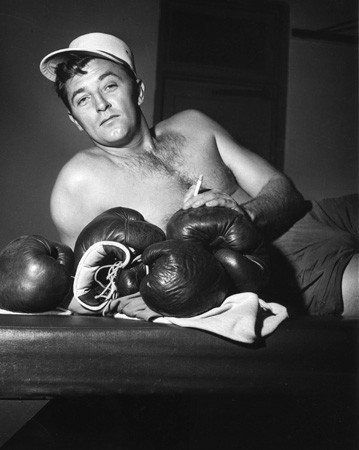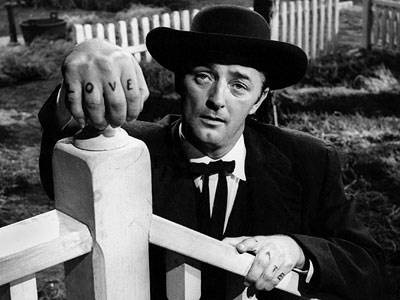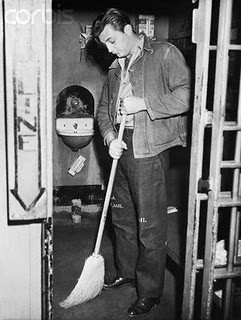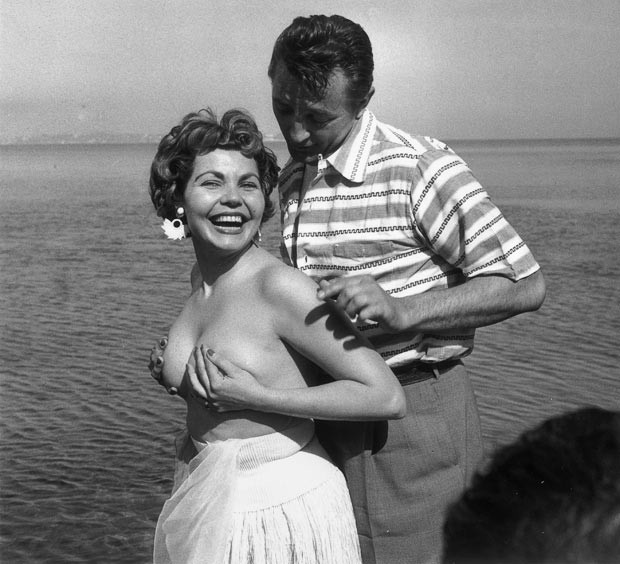Scandals of Classic Hollywood: Robert Mitchum, Smokin’ the Dope
by Anne Helen Petersen

Hey, do you recognize this guy?
Smoking hot, amiright? But also kinda looks like he wants to take you to the boiler room and make out Jordan Catalano-style?
This guy is Robert Mitchum, and that sense of impending doom stems from the fact that:
1) When he was a kid during the Depression, he ran away from home, was arrested for “vagrancy,” and was put on an honest-to-god chain-gang. He escaped and, according to lore, nearly lost his leg, eventually making his way to California and scrapping his way into B-pictures.
2) He’s probably best known for his role in Night of the Hunter, in which he pretty much plays the most dastardedly character imaginable. Preacher, serial killer, “Love” and “Hate” tattooed on his knuckles way before Radio Raheem — pure creepfest. But also somehow hot?!? Like how I feel about Ed Norton in American History X?! I feel so confused!
But between the chain-gang-ing and Night of the Hunter, Mitchum nearly brought down his entire career — and the rest of Hollywood — for . . . wait for it . . . smoking weed.

Now, I realize that even today’s stars get chastised for, as my mom and Frances McDormand in Almost Famous would say, “smokin’ the dope.” See the hoopla over Kristen Stewart (over-the-top) and Michael Phelps (okay, fine). But Mitchum got caught before the ’60s, before Half Baked was something that people over 30 quoted in everyday conversation, before most adults in America (including presidents) admitted to trying it.
So what Mitchum got caught smoking was important, but it was even more important that he got caught at all. Here’s why.
[UNCEREMONIOUS BREAK FOR BRIEF FILM HISTORY LESSON]
During the ’30s and early ’40s, the “Big Five” and “Little Three” studios (including MGM, Warner Bros, Paramount, and other company names you still see flashed before films today) controlled Hollywood. Each of these studios functioned like a little mini-star-factory, gobbling up raw “star material” from vaudeville, soda pop fountains, and street corners and turning it, through lots of elocution lessons, PE classes, and dramatic makeovers, into stars. They changed names; they changed backgrounds, they changed hairlines. (Columbia used electrolysis to make Rita Hayworth’s, née Margarita Cansino’s, hairline appear less “Latin.”)
Stars signed contracts for seven years, and the studio could basically make them do whatever they wanted: tell them who to date, put them in five movies a year, control their diets. (MGM to Judy Garland: Take this speed, it’ll help you lose that baby weight!)
And when and if the stars screwed up, the studios cleaned it up. Each studio had a team of “Fixers” who would come make things right when, say, Clark Gable drunkenly crashed his car into a stop sign for the eighth time that month. (Think George Clooney in Michael Clayton minus the silver foxiness).
Which is all to say that from the late ’20s to the early ’40s, the stars all had squeaky clean, carefully polished images, with indiscretions tidied up the same way that Mr. Clean White Eraser cleans up the keyboard of my filthy MacBook. (So when you hear someone horrible and shrill complain about how scandalous stars are today, set them straight: The wealthy and beautiful have always done crazy shit; it’s just that cover-up these days is poorer.)
But by 1948, a number of changes in the way the studios did business (the end of interminable contracts; monopoly-busting on the part of the government) made it so that the studios’ factory-like operations were no longer possible. I could write you like two chapters on the specifics (I totally did; it’s called a dissertation; it‘s nigh unreadable) but that sort of thing is interesting to 0.00007% of the population.
So when Mitchum got caught, by the police, with marijuana, in the apartment of a young starlet who was so not his wife, it was greeted like a gust of wind that could bring down the entire Hollywood house of cards.
So back to the down-and-dirty:
When Mitchum was arrested on September 1st, 1948, it made front-page news across the country. Well-aware of how the majority of old and aspiring biddies would greet the news, Mitchum declared his career over.
But the juicy part was the promise of continued revelations to come. As a detective informed the Los Angeles Times,
We’re going to clean the dope and narcotics users out of Hollywood. We don’t care who we have to arrest. There’s a lot of ‘stuff’ being used in Hollywood. We have a number of important and prominent Hollywood screen personalities under surveillance. Many of the big shots, stars and other top names, do not patronize corner peddlers for fear of a shakedown. However, we have reason to believe there is an ‘inside ring,’ right inside the film industry, supplying a larger number of narcotics users.
You guys, this was like Heidi Fleiss to the Barry Bonds power, and it broke on the front page of newspapers across the country. This was as if my liberal arts undergraduate institution, which has long protected its underage drinking population from police records by relegating all drinking issues to campus security (picture long-suffering middle-aged quasi-cops politely asking half-naked students tromping across the campus green with tallboys of Busch Light to “pour that out; be safe now; make sure you have a towel to cover-up after you run the Beer Mile completely nude”), was suddenly swarmed by M.I.P.-issuing police.

While there was no TMZ to print Mitchum’s mug shot, there were photos of his prison stay. This was no Paris Hilton country club prison, or the “prison” in Goodfellas where they sliced the garlic with the straight razor: Mitchum, in full prison duds, was dutifully mopping the floor.
But Mitchum’s career was rescued — and for three specific reasons:
First, Mitchum had become a star based on his performance in film noir, establishing him image as that of an anti-hero. In other words, a guy who played criminals smoking a big bad drug….not a huge surprise, at least not the sort of surprise it would have been if Shirley Temple was caught with a joint.
Second, Mitchum’s studio didn’t throw him over. RKO and David O. Selznick (of Ingrid Bergman non-image-making fame) co-owned Mitchum’s contract. Like most Hollywood stars, Mitchum’s contract included a “purity clause,” but the clause was worded in “nebulous fashion” — e.g. the clauses was for show, a means of Hollywood showing that they upheld a certain standard of moral righteousness. So Mitchum kept his job — and started work on a new film as soon as he was let free from jail.
Third, and most awesomely, Mitchum gave himself — and his family — over to the cause of image rehabilitation. Estranged from his wife and two young boys at the time of the arrest, he was now “happily reunited” with them upon release. While he was in jail, he “wrote” (read: a publicity agent wrote) a public apology, very earnestly asking “Do I Get Another Chance?” The article was published in Photoplay, which was basically the People magazine of its time, only less “Nuns Cure Genital Warts in the Land that God Forgot” and more “Debbie Reynolds Tells You How to Win a Boy Who Respects You!”
SO TAKE A DEEP BREATH GUYS, THIS APOLOGY IS SO GOOD:
A motion picture actor lives in a world of lights and shadows. Folks on the outside looking in see us not as we really are but as they believe, or want to believe, we are. In the last few months I’ve been surrounded by shadows….My troubled moments have been illuminated by the shining faith for my wife, Dorothy, with whom for the first time since we were married, I have an understanding and companionship which I had almost abandoned hope of finding.
If I can live through this ordeal and grow in stature, because of it, nothing the future can dish up will get me down. I’m not looking for pity. It’s a good thing that I’m doing time in jail. Its not in the cards that anyone can escape paying for the wrong things they do. No matter how the cards are shuffled, you pay, in one way or another. That’s the law of life….I would not want anyone in this world to get the idea that things were fixed for me in court because I am a movie star. I wouldn’t want to walk down the street and have folks looking at me sideways. I wouldn’t want it whispered that there was anything about my trial that was not on the level….there are quite a few answers that I haven’t got yet in this startling life drama in which I’m starring
Now I am facing life with a new sense of responsibility to the world, to myself, and above all to my wife and our two sons…I know that my moral fiber has toughened. I know that I will make my boys proud to call me their father. Could a man have a greater incentive? I said it before, and I say it again. You’re the jury. What will the verdict be?
The lyricism! The lights and shadows, the law of life! WHAT WILL THE VERDICT BE? If Robert Downey Jr. ever falls of the wagon (I’m not saying I want him to, but you guys, did you forget that he was so strung out in the late ’80s that he regularly ended up in random people’s Hollywood homes? Like bedrooms, coked out of his mind? The rehabilitative power of blockbuster franchises!) I want him to write a TMZ blog post that just tries to correctly use “whom” and “for which.”
Unlike Bergman, who basically told her studio and handlers to f-off while she followed her heart, Mitchum allowed photographers to take pictures of him frolicking with his sons, being a good dad, and most definitely not smoking anything illegal. He made himself a stooge, and his career survived.
His image was reformed, but Mitchum was not, and a series of scandalous revelations would emerge over the course of the 1950s. Some, like one published in Confidential (the TMZ of its time, only in print with worse puns) alleging that he stripped and made himself into a “human hamburger” at a recent party, were unconfirmed, but others, such as the dozens of photos snapped of him on a beach at Cannes, posing with a enterprising young starlet who tore off her top in the middle of the photo shoot, left Mitchum looking very much like a kid with his hand in the boobie, er, cookie jar.

Mitchum’s arrest illuminated the unseemly underbelly of Hollywood — an underbelly that had been neatly covered and Spanxxed since the early 1920s, when a series of ridiculously juicy scandals (to come! I promise!) frightened the studios into controlling their stars and doing their mightiest to cover up their wanton lifestyles.
Since this peep-hole re-opened, it has never closed. Mitchum was followed by Bergman, who was followed by the overarching scandalousness of Marilyn Monroe and Marlon Brando, who were followed by the love triangle of Elizabeth Taylor, Eddie Fisher, and Debbie Reynolds. Today some stars, like, say, Angelina Jolie and 1990s Tom Cruise, are better at covering up their potentially offensive and alienating life choices than others, but the era of the “Fixers,” and the ability to completely control one’s image, is over.
In the end, the lesson of Mitchum is one of rhetoric: The more you supplicate, the more you appeal to fans’ sense of agency, the more you substitute bad behavior with good patriarchal behavior, the easier it is to remain a box office draw. Mitchum’s handlers knew this; every tell-all interviewee with Barbara Walters learned from this. So the next time you get caught smoking weed with someone who isn’t your husband or wife, just write a nice letter using a lot of prepositions and weather metaphors. You can even use that one above. I promise not to tell.
Previously: Ingrid Bergman, Instrument of Evil.
Anne Helen Petersen is a Doctor of Celebrity Gossip. No, really. You can find evidence (and other writings) here.